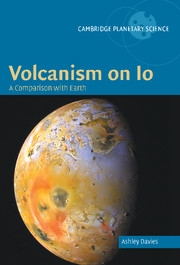Book contents
- Frontmatter
- Contents
- Preface
- List of Abbreviations
- Reproduction Permissions
- Introduction
- Section 1 Io, 1610 to 1995: Galileo to Galileo
- Section 2 Planetary volcanism: evolution and composition
- Section 3 Observing and modeling volcanic activity
- Section 4 Galileo at Io: the volcanic bestiary
- Section 5 Volcanism on Io: the global view
- Section 6 Io after Galileo
- Appendix 1 Io hot-spot locations
- Appendix 2 Io maps
- References
- Index
- Plate Section
Appendix 1 - Io hot-spot locations
Published online by Cambridge University Press: 05 October 2014
- Frontmatter
- Contents
- Preface
- List of Abbreviations
- Reproduction Permissions
- Introduction
- Section 1 Io, 1610 to 1995: Galileo to Galileo
- Section 2 Planetary volcanism: evolution and composition
- Section 3 Observing and modeling volcanic activity
- Section 4 Galileo at Io: the volcanic bestiary
- Section 5 Volcanism on Io: the global view
- Section 6 Io after Galileo
- Appendix 1 Io hot-spot locations
- Appendix 2 Io maps
- References
- Index
- Plate Section
Summary
This table of Io's active hot spots has been compiled from identifications of hot spots in data from Voyager IRIS (Pearl and Sinton, 1982; McEwen et al., 1992, 1996); SSI (McEwen et al., 1997, 1998a; Keszthelyi et al., 2001a; Geissler, 2003; Turtle et al., 2004); NIMS (Lopes-Gautier et al., 1997, 1999, 2000; Lopes et al., 2001, 2004); PPR (Spencer et al., 2000b; Rathbun et al., 2004); and terrestrial telescopes (Goguen et al., 1998; Marchis et al., 2001; de Pater et al., 2004; Marchis et al., 2005). Hot spots in bold type have temperatures in excess of 1000 K as determined from SSI data (summarized in Geissler [2003]), NIMS data (Davies et al., 1997, 2000b; Lopes-Gautier et al., 2000; Davies et al., 2001, 2003b), and ground-based instruments (Marchis et al., 2002). This list will no doubt expand as more data are obtained and analyzed. Provisional names for features are in italics. Detections are indexed as follows: I = Voyager IRIS; S = Galileo SSI; N = Galileo NIMS; P = Galileo PPR; E = Earth-based or Earth-orbiting telescopes; C = Cassini ISS. All of the hot spots are plotted in Plates 13b and 16a.
The positions of hot spots are subject to uncertainties caused by different observation resolutions and movement of thermal sources, as well as by reference to nearest feature rather than the hot spot itself.
- Type
- Chapter
- Information
- Volcanism on IoA Comparison with Earth, pp. 305 - 309Publisher: Cambridge University PressPrint publication year: 2007

